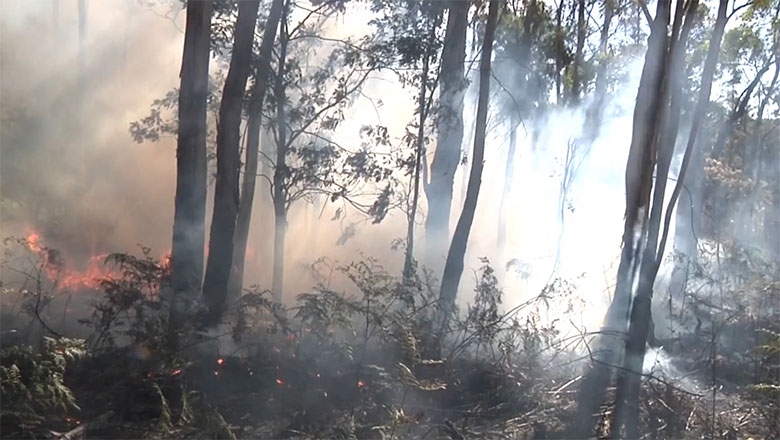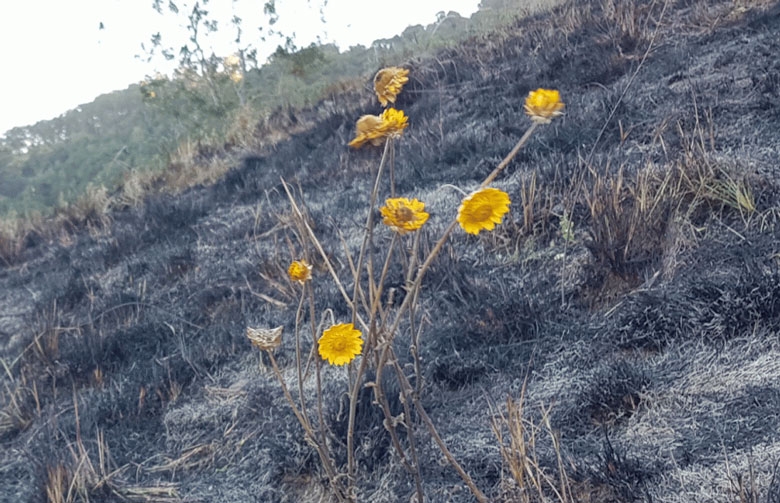Cool burning for country and community
Firesticks Alliance Indigenous Corporation has been working to re-establish cultural burning around the country—in overdrive since the black summer of 2019–20.
Eastern Australia: Firesticks Alliance Indigenous Corporation registered in 2018 with members in all 5 eastern Australian states and territories. The corporation supports community leadership among all those seeking to revive cultural burning as part of their land management strategy.

A cool burn on Yuin country, National Indigenous Fire Workshop 2019. The flames never reach the canopy and the remains are charcoal, not a pale grey ash.
The fire in a cultural burn is very different to either a wildfire or to ‘hazard-reduction’ burning. It depends on being very familiar with country. If you can read the land, its soil and vegetation, you know where and when it’s right to light it up. Regular cultural burning keeps country healthy, nurtures native wildlife, and can bring long-damaged country back to life. The fire is relatively cool, leaving the canopy untouched; the smoke is pale and dissipates quickly; and within a couple of weeks new shoots appear.
One of Firesticks Alliance’s founding members is Victor Steffensen, who was taught cultural burning knowledge and practices by Kuku Thaypan elders in Cape York. (For a good introduction to cultural burning and its connection to culture and community, read his book Fire Country.)

Doctors G. Musgrave and T. George, Kuku Thaypan elders who led the revival of cultural burning across Australia.
Image credit: V. Steffensen, 2005
Steffensen has spent decades encouraging the revival of cultural burning practices—and dealing with the obstacles to it. Importantly, he has also run workshops all around the country, teaching people who are crying out to learn, and generating revelation among sceptics and detractors.
Steffensen’s workshops inspired many communities across Australia to become active in the movement to revive cultural burning—to ‘carry the torch’ both literally and figuratively. That activity coalesced as Firesticks Alliance Indigenous Corporation.
Firesticks became an active partner in delivering the National Indigenous Fire Workshop, which evolved from the Kuku Thaypan Fire Management Research Project and which draws more people every year. As Victor Steffensen says:
The workshop brings everyone together, and the network keeps growing. It’s truly community-driven. It’s community mentoring community. We are all determined to have Indigenous knowledge recognised in mainstream fire management solutions.
Clearly, the corporation was busy from the outset. In 2019 its income grew from zero to over $300,000 through a combination of fee-for-service work with communities, and partnering with communities in government grants and sponsorships.
Then came the long, fierce fire season of 2019–20, and suddenly the seeds of decades of effort yielded a bumper crop of interest. For the corporation, it was almost too much—rapid growth can be a governance challenge. As it grows, the core team works harder and harder, which can lead to burnout. In the year ending June 2021, Firesticks' income was $1.74 million and it had 9 employees.
In expanding their operations, Firesticks have taken care to adhere to cultural protocol. It has established a shared leadership team, which together works as a CEO and is overseen by the board. It has appointed ongoing staff, and it is formalising its mentoring and training programs with the aim of certifying 100 cultural fire practitioners. To support its work, the corporation has also established partnerships with various value-aligned organisations. There continues to be great interest from all sectors of the community—see the comments from donors to its fundraiser.

For Firesticks, it’s not all about the fire. The corporation knows—and seeks to amplify its knowledge—that cultural fire is connected to all elements of the knowledge map and all aspects of cultural practice. It is working to connect communities, and to enable Indigenous people to share their knowledge and their solutions to contemporary challenges. It is helping to connect the people to country and each other. It is encouraging communities to walk with their fire, to tend country, personally and collectively. In this way it is building resilience for the future.